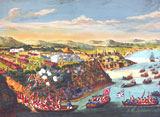|
|
|
|
|
|
|
|
|
The Expulsion of the Acadians The fall of Louisbourg The Expulsion of the Acadians
Acadia and Louisbourg
(Canadian War Museum, 1.D.1.4-CGR5) 
A View of the Plundering of
and Burning of the City of Grymross
Painting by Thomas Davies, 1758 Courtesy of the National Gallery of Canada, 6270 After New England troops captured Port Royal in 1710, Acadia became Nova Scotia. Now British subjects, the Acadians refused to take an oath of allegiance to Britain. Their close ties to the French and Mi'kmaqs alarmed the British authorities. In 1755, Governor Charles Lawrence expelled 7,000 Acadians. Every Acadian farm was burned to the ground, families were torn apart, and hundreds died of shipwreck and disease. After the fall of Louisbourg in 1758, the Royal Navy and the British army hunted down and deported about 3,000 Acadians. This relentless pursuit took them 70 kilometres inland up the Saint John River to burn an Acadian refugee community. When peace returned, Acadian refugees rebuilt their society on the south shore of the Gulf of St. Lawrence. The Fall of LouisbourgLouisbourg flourished as a naval base, fishing port, and commercial centre until 1758. In that year, 13,000 British soldiers and a massive fleet attacked the fortified city and overwhelmed 4,000 French defenders. The British deported Louisbourg's residents to France and abandoned the remains of the fortified city at the end of the war. |
|||||||||||||||||||||||||||||||||||||||||||||||||||||||||||||||||||||||||||||||||||||||
